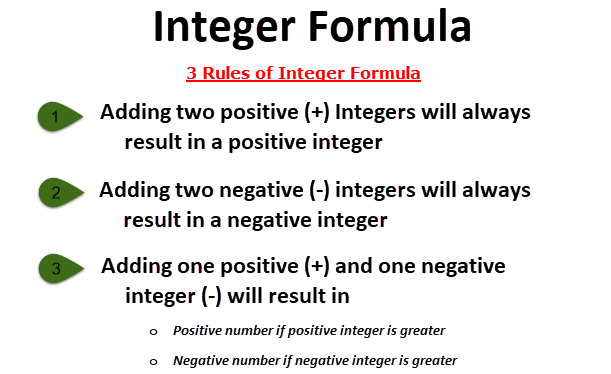Updated July 28, 2023

Integer Formula (Table of Contents)
Integer Formula
Any number that can be written without fractions is known as an integer. So, integers are whole numbers that can be positive, zero, or negative but no fractions.
A set of integers is denoted by Z, which can be written as Z = {…-5,-4,-3,-2,-1, 0, 1, 2, 3, 4, 5…….}. Here Z is a set that has a property of Denumerability which tells us that although there is an infinite number of elements in Z, those values are countable and can be identified in the set. The real number includes all the numbers, including fractions also, and real numbers can be converted into integers by rounding the number to the nearest integer. For example, 1, 34, 9890, 340945, etc., all are integers, and 9.4, 34.56, and 803.45 are real numbers that can be rounded off to 9, 35, and 803, which are integers.
Formula For Integer:
There is no particular formula for an integer, as it is nothing but a set of numbers. But there are certain rules when we perform any mathematical operations like addition, subtraction, etc, on integers:
- Adding two positive integers will always result in a positive integer.
- Adding two negative integers will always result in a negative integer.
- Adding one positive and one negative integer will result in
- Positive number if a positive integer is greater
- Negative number if a negative integer is greater
Examples of Integer Formula
Let’s take an example to understand the calculation of the Integer formula in a better manner.
Example #1
Let’s say we have a set of integers and is given by Z = {2,3,-3,-4,9}
Solution:
Let’s try to understand the rules which we discussed above.
- Adding two positive integers will always result in a positive integer.
So let’s take 2 positive integers from the set: 2, 9.
So 2+9 = 11, which is a positive integer.
- Adding two negative integers will always result in a negative integer.
So let’s take 2 negative integers from the set: -3, -4.
So -3-4 = -7, which is a negative integer.
- Adding one positive and one negative integer will result in
1. Positive number if a positive integer is greater.
So let’s take one positive and one negative integer from the set: -3, 9.
So -3+9 = 6, which is a positive integer.
2. Negative number if a negative integer is greater.
So let’s take one positive and one negative integer from the set: -3, 2.
So -3+2 = -1, which is a negative integer.
Example #2
Let’s say you are performing some mathematical equation where you know that sum of two consecutive integers is given by 97. Now you want to find out what those numbers are.
Solution:
Assume that the 1st integer is x.
The 2nd integer will be x + 1.
So,
- x + (x + 1) = 97
- 2x + 1 = 97
- 2x = 97 – 1
- 2x = 96
- x = 96 / 2
- x = 48
So, the 1st integer is 48
and 2nd integer is 48 + 1 = 49
Explanation
Integer, as explained above, is a set of numbers that contains all numbers except fractional numbers. Integers can be positive or negative. Even 0 is also an integer. Also, as we have seen in the above examples, addition, subtraction, and multiplication of two or more integers will always result in integers, but this is not the case with the division function. Using division can result in an integer or a fraction. For example, if we divide 10 by 2, we will get 5 which is an integer, but if 10 is divided by 4, it is 2.5, which is not an integer.
Relevance and Uses of Integer Formula
Integers are used in programming languages and coding because these systems only understand binary numbers i.e., 1 or 0. So everything or anything a computer system does converts into binary numbers first. Integers are used in mathematics, finance, statistical tools, etc. Basically, they are the core element of all these fields. Integers are important not only in statistical tools and mathematical operations but also in real life. That is an integer if you want to count how much money you have in your wallet. If you want to count how many students are in the class, again, an integer. The number of trees in your backyard, the number of cars you have, the number of years of experience you have, etc, all are integers. So the intensity integers in real life are so large that they cannot be measured. In a single line, we can say that integers are everywhere.
Recommended Articles
This has been a guide to Integer Formulas. Here we discuss How to Calculate Integer along with practical examples. You may also look at the following articles to learn more –
